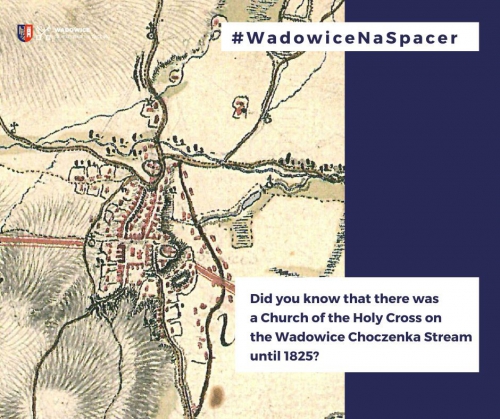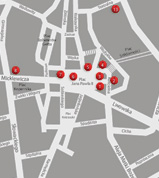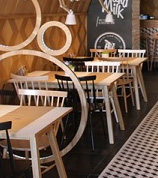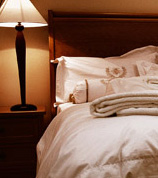
#WadowiceNaSpace or a Walk on the trail of temples and shrines in the Wadowice Municipality
This week, as part of our #WadowiceNaSpace series, we would like to take you on a walk on the trail of forgotten and lesser-known temples and shrines in the Wadowice Municipality. Did you know that there was a Church of the Holy Cross on the Wadowice Choczenka Stream until 1825? Among the religious buildings in the Wadowice Municipality, you will find historic churches, modest chapels, as well as modern architectural solutions.
Walking the trail of churches and shrines in the Wadowice Municipality is a great way to spend a summer afternoon. A Google map prepared by us will help you:https://www.google.com/maps/d/viewer?mid=1fSCBEPGtnkWVCKNm-7Iemfac2mYBz8E&fbclid=IwAR2s9eew4T87BI23mzYZyMokHAGKqkkZcaXaP1Df63obycARTQGvwJzI1hk&ll=49.86848911135551%2C19.52991565000002&z=13
- Holy Cross Church on the Choczenka Stream, Wadowice
The church stood in the area of the so-called "Bydlany Rynek" (today's Plac Obrońców Westerplatte), and it was founded in 1735 by Wadowice resident Reverend Paweł Zychowicz, dean of Zator, parson of Wieprz and Andrychów. The new temple was built on the site of a 16th-century (dated 1541) wooden Chapel of the Holy Cross maintained from the income of the town's brewery. Due to its old age and dilapidation through the constant flooding of the Choczenko Stream, the new Holy Cross church was finally demolished in 1825, and some of the paintings were moved to the parish church (now the Minor Basilica of the Presentation of the Blessed Virgin Mary).
Photo : Wadowice in the 18th century; „Galicja na józefińskiej mapie topograficznej 1779 - 1783 tom 1 część A i B”, W. Bukowski (ed.), PAN 2012.
- Pedestal with Christ the King, Ponikiew
It is one of the oldest shrines in Ponikiew. The pedestal with Christ the King reminds us of the legend of the Route of Jan Kazimierz - which tells of the king being led through the mountain peaks by the inhabitants of Ponikew during the Swedish Deluge. It is the legendary road "Trakt Królewski" today called Jaśkowa Droga. From Żywiec through Łamana Skała, Leskowiec, the Brejna Valley, and Łysa Góra up to the road to Wadowice, King Jan Kazimierz was led to his homeland. The shrine was to be erected on the former cemetery of the royal dragoons, who fell in battle in the mountain gorge in defense of the returning king. The pedestal also commemorates the tragedy of the locals caused by Suvorov’s army during the capture of rebels from under Lanckorona (the Bar Confederation).
- A Grave in Księży Forest, Chocznia
Here the tragic years of Nazi Germany's occupation are commemorated by an iron cross with a plaque and three symbolic graves. In the eastern part of the forest, known as "Księża Barcia," opposite the old training ground of the 12th Infantry Regiment the Germans shot in the forest ravines Polish patriots held in town jails. They were mostly young underground activists and partisans. Of the approximately twenty murdered, only one was identified after the war; a resident of Chocznia, 32-year-old A. Turała, a Home Army soldier. The exhumed corpse of the partisan was buried in the Chocznia cemetery.
- Cemetery Chapel in the parish cemetery, Wadowice.
The chapel, built in 1862 is the centerpiece of the parish cemetery in Wadowice. It was endowed by Maria née Słap-Wilczyńska and her siblings. Originally a burial chapel of the wealthy Słap and Wilczyński families, today it is owned by the parish. The chapel is an inverted-oriented religious building (i.e. the presbytery was placed on the western side) built on a rectangular plan with an entrance on the eastern side, closed with a semicircle. A stone staircase secured by metal railings fastening decorative pillars with vases leads to the entrance with stone doorframes. In the side walls, one will find two semicircular at the top windows on each side. The chapel has a gabled roof with a signature tower in front. On both sides of the entrance door there are commemorative plaques dedicated to, in turn: the Słapa family, Rev. Tadeusz Włodyga, Rev. Leonard Prochownik, and Rev. Dr. Edward Zacher. In the chapel we find a wooden pseudo-Baroque altar with a sculpture of the Crucified Christ and the inscription "Wieczny odpoczynek" ("Eternal rest"). On the sides are four statues. Information about those buried in the crypt in the basement can be found on the epitaphs on the walls: Franciszek Wilczyńsk, Alexander Słapa, Katarzyna Słapa.
- Lawrence the Martyr Church, Klecza Dolna
The brick neo-Gothic church of 1906 - 1908 was built after the wooden temple burned down in the second half of the 17th century. The author of the design of this church is the prominent Kraków architect Jan Sas-Zubrzycki, who had a significant influence on the sacred architecture of his time. This church was consecrated on the 28th of August, 1910, by the Suffragan Bishop of Kraków, Anatol Nowak. The organ, which still exists today, was built in 1918, while the main altar was constructed in 1920. The temple of his design in Klecza has survived unchanged to this day. In the immediate vicinity, implementations of his designs can be found in Zator (town hall), Myślenice (town hall), and Trzebinia (church), among others. Complementing the site is the neo-Gothic ancestral chapel of the Sławiński family, located across the road, built on the site of a burned church. It was endowed by Przecław Sławiński, the heir of Klecza at the time. Over the entrance to the building, there are the coats of arms of Sławiński (Leliwa) and Borowski (Jastrzębiec) - the coat of arms of Przecław's wife, Helena.
- Erasmus Church in Barwałd Dolny
The wooden parish church in Barwałd Dolny was built in the second half of the 18th century and was founded by Jan Biberstein-Starowieyski, starost of Barwałd. It is a single-nave building with a log structure, boarded and covered with shingles. The tower is a remnant of the previous 16th-century Church of the Assumption of the Blessed Virgin Mary. The layout where the tower is located on the east side of the chancel, is unusual and rare; with sloping walls, it is topped by a bull's-eye helmet with a lantern. It consists of three stories separated by eaves roofs. The church interior is covered with ceilings. The 18th-century painting decoration of the walls and ceilings consists of figural, floral, and geometric motifs. On the ceiling of the chancel is a painting of the Annunciation of the Blessed Virgin Mary, and in the nave is the Transfiguration of the Lord on Mount Tabor. Among the 16th-18th century furnishings of the Barwałd church we find: an 18th-century main altar with a painting of St. Erasmus and a Baroque tabernacle; a late-Gothic crucifix from the first half of the 16th century set on the chancel beam; a stone Baroque baptismal font; and a Rococo organ from 1770. The temple is surrounded by a stone wall with two gates from 1863/64.
- Church of the Immaculate Heart of the Blessed Virgin Mary in Stanisław Górny
The history of the church and parish in Stanislaw Górny begins with the decree of Fr. Cardinal Macharski issued in connection with the separation of new parishes in 1985. The parish in question was composed of the areas of the two parishes of Marcyporęba and Zebrzydowice Reverend Eugeniusz Łudzik, at that time a pastor of the parish in Macyporęba, began efforts to build a church in Stanisław Górny and a chapel in Brzeźnica. After receiving the appropriate permits in 1980, construction began. Originally it was supposed to be a wooden votive church moved from Tłuczań, with a lower spacious brick chapel covered with earth. In time, that idea was abandoned, and a different design by J. Wzorek and M. Cempel was implemented; a modern, large, two-story structure with a soaring tower. Residents of the two villages, Górny and Dolny Stanisław, began construction work. Since the foundations of the structure had been prepared earlier for the church in Tłuczań, the design had to be adjusted. Therefore, the temple was built with only two naves, the main and side aisles on the south side. By 1983, the lower part of the church was completed and the walls of the upper story were erected to the height of the organ choir. The furnishings of the church were designed by Wł. Flis from elements of unpolished ceramics of his own making. In mid-1983, a new parish encompassing Stanisław Górny and part of Stanisław Dolny was erected by Cardinal Fr. Macharski, who appointed Fr. Zygmunt Kuźma as pastor. The temple was completed during his tenure, and a rectory, parking lot, and cemetery were built. In the church interior, interestingly made ceramics attract attention: the image of the Mother of God and the Stations of the Cross.
- Margaret's Chapel 1879 in Kaczyna
The brick chapel of St. Margaret, with the privilege of celebrating Mass, is located on the grounds of the Chocznia parish of the Nativity of St. John the Baptist According to the inscription above the entrance, it is assumed that it was built in 1879, and in 1938 it was expanded to include a sacristy. A Rococo-style altar from 1787 with paintings of the Blessed Virgin Mary and a moving image of St. Margaret was placed in the center,. On the sides of the altar are placed statues of St. Peter and St. Paul. This altar was the main altar in the former parish church in Chocznia, before the new church was built in 1883.
Photo : Google Maps
#Wadowice #WadowiceMunicipality #OnAWalk #Sacrum #Temple

.png)






